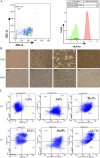FANCA promotes lung adenocarcinoma progression and is a potential target for epitope vaccine immunotherapy
- PMID: 39375712
- PMCID: PMC11460194
- DOI: 10.1186/s12967-024-05675-w
FANCA promotes lung adenocarcinoma progression and is a potential target for epitope vaccine immunotherapy
Abstract
Background: FANCA mutations have been detected in a variety of cancers and found to be pro-carcinogenic. However, no functional studies have been identified regarding the involvement of FANCA in the occurrence and the immune response of LUAD.
Methods: The mRNA expression and overall survival rates of FANCA were evaluated by the TIMER, PrognoScan and TCGA database in LUAD tissues, and FANCA expression was further validated by clinical serum samples using ELISA. The correlation between FANCA and immune infiltration level was investigated via TISIDB database and CIBERSORT algorithm. The Kaplan-Meier plotter was used to further evaluate the prognostic value based on the expression levels of FANCA in related immune cells. Then, the influence of FANCA knockout on the proliferation, migration, and invasion of A549 and H1299 cells was validated using CCK8, cloning formation, and Transwell assays. Subsequently, HLA-A2-restricted FANCA antigenic peptides were predicted and synthesized by NetMHC4.0 and SYFPEITHI, and DCs were induced and cultured in vitro. Finally, DCs loaded with HLA-A2-restricted FANCA antigenic peptides were co-cultured with autologous peripheral blood lymphocyte to generate specific CTLs. The killing effects of different CTLs on LUAD cells were studied.
Results: The results showed that high levels of FANCA in patients with LUAD were significantly correlated with worse OS survival, which was correlated with age, clinical stage, pathological T stage, M stage, and N stage in LUAD. Knockdown of FANCA in A549 and H1299 cells significantly inhibited proliferation, metastasis, and invasion in vitro. In addition, FANCA was significantly related to immune infiltrate, genomic alterations and TMB. FANCA expression infuenced the prognosis of LUAD patients by directly affecting immune cell infltration. Finally, HLA-A2-restricted FANCA antigenic peptides were synthesized. And FANCA 146-154 (SLLEFAQYL) antigenic peptide exhibit a stronger affinity for DCs, and induce CTLs to produce stronger targeted killing ability for LUAD cells at an effector-to-target ratio of 40:1.
Conclusion: These results demonstrated that the elevation of FANCA promotes malignant phenotype of LUAD, and the potential peptide P2 (SLLEFAQYL) derived from FANCA may be used as an epitope vaccine for the treatment of LUAD.
© 2024. The Author(s).
Conflict of interest statement
The authors declared no competing interests that could potentially infuence or bias the outcomes of this research.
Figures









Similar articles
-
FAM207BP, a pseudogene-derived lncRNA, facilitates proliferation, migration and invasion of lung adenocarcinoma cells and acts as an immune-related prognostic factor.Life Sci. 2021 Mar 1;268:119022. doi: 10.1016/j.lfs.2021.119022. Epub 2021 Jan 9. Life Sci. 2021. PMID: 33434533
-
Fatty acid metabolism prognostic signature predicts tumor immune microenvironment and immunotherapy, and identifies tumorigenic role of MOGAT2 in lung adenocarcinoma.Front Immunol. 2024 Oct 16;15:1456719. doi: 10.3389/fimmu.2024.1456719. eCollection 2024. Front Immunol. 2024. PMID: 39478862 Free PMC article.
-
Prognostic value and immune infiltration of a novel stromal/immune score-related P2RY12 in lung adenocarcinoma microenvironment.Int Immunopharmacol. 2021 Sep;98:107734. doi: 10.1016/j.intimp.2021.107734. Epub 2021 Jun 25. Int Immunopharmacol. 2021. PMID: 34175738
-
PLCG2, A Regulator of Lung Adenocarcinoma Proliferation and Migration Associated with Immune Infiltration.Curr Cancer Drug Targets. 2025;25(2):159-169. doi: 10.2174/0115680096307100240801095132. Curr Cancer Drug Targets. 2025. PMID: 39177130
-
Upregulation of M6A Reader HNRNPA2B1 Associated with Poor Prognosis and Tumor Progression in Lung Adenocarcinoma.Recent Pat Anticancer Drug Discov. 2024;19(5):652-665. doi: 10.2174/0115748928258696230925064550. Recent Pat Anticancer Drug Discov. 2024. PMID: 37877146
Cited by
-
Combining single-cell analysis and molecular docking techniques to construct a prognostic model for colon adenocarcinoma and uncovering inhibin subunit βb as a novel therapeutic target.Front Immunol. 2025 Jan 9;15:1524560. doi: 10.3389/fimmu.2024.1524560. eCollection 2024. Front Immunol. 2025. PMID: 39850875 Free PMC article.
-
Identification of new HLA-A*0201-restricted cytotoxic T lymphocyte epitopes from LDHC in lung adenocarcinoma.Front Immunol. 2025 Apr 9;16:1564731. doi: 10.3389/fimmu.2025.1564731. eCollection 2025. Front Immunol. 2025. PMID: 40270965 Free PMC article.
References
-
- Thai AA, Solomon BJ, Sequist LV, Gainor JF, Heist RS. Lung cancer. Lancet. 2021;398(10299):535–54. 10.1016/S0140-6736(21)00312-3. - PubMed
-
- Sorin M, Rezanejad M, Karimi E, Fiset B, Desharnais L, Perus LJM, Milette S, Yu MW, Maritan SM, Doré S, Pichette É, Enlow W, Gagné A, Wei Y, Orain M, Manem VSK, Rayes R, Siegel PM, Camilleri-Broët S, Fiset PO, Desmeules P, Spicer JD, Quail DF, Joubert P, Walsh LA. Single-cell spatial landscapes of the lung tumour immune microenvironment. Nature. 2023;614(7948):548–54. 10.1038/s41586-022-05672-3. - PMC - PubMed
MeSH terms
Substances
Grants and funding
LinkOut - more resources
Full Text Sources
Medical
Research Materials
Miscellaneous

